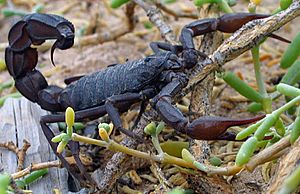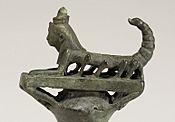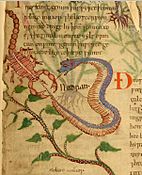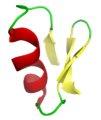Scorpion facts for kids
Quick facts for kids ScorpionsTemporal range: Late Ordovician - Recent, 468 - 0 Mya
|
|
|---|---|
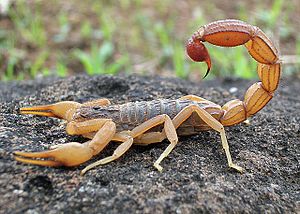 |
|
| Hottentotta tamulus from Maharashtra, India | |
| Scientific classification | |
| Kingdom: | |
| Phylum: | |
| Class: | |
| Order: |
Scorpiones
|
Scorpions are amazing creatures with eight legs. They are a type of arachnid, like spiders. Scorpions have a long body and a tail that ends with a venomous sting. Most adult scorpions are about 3 inches long.
Scorpions have been around for a very long time. Their ancestors lived over 470 million years ago, during the Ordovician period. They have learned to live in many different places, from deserts to forests. You can find scorpions on every continent except Antarctica. There are 13 main groups, or families, of scorpions alive today.
Contents
- Scorpion Body Parts
- How Scorpions Survive in the Desert
- What Scorpions Eat
- Scorpion Life Cycle and Reproduction
- Scorpions and People
- Scorpion Stings and Venom
- Animals That Hunt Scorpions
- Scorpions as Food
- Scorpions as Pets
- Scorpions in Culture
- Interesting Facts About Scorpions
- Related pages
- Images for kids
- See also
Scorpion Body Parts
Scorpions have eight legs, just like spiders. They also have two large claws, called pedipalps, which they use for grabbing things. Their tail is thin and made of several parts. It usually curves up over their back. At the end of the tail is a venomous stinger.
A scorpion's body has three main sections. The front part is called the cephalothorax. The middle part is the mesosoma, which is like their abdomen. The tail part is called the metasoma. Their body is covered by a hard outer shell, called an exoskeleton. This shell helps to protect them.
How Scorpions Survive in the Desert
Scorpions have special ways to live in the desert. They can slow down their body processes, known as their metabolism. This means they can survive on very little food, sometimes just one insect a year! This ability also helps them hide from the sun and heat for a long time. They use very little oxygen when they do this.
Many people think a scorpion's claws were once front legs. These legs changed over time through evolution to become the strong claws we see today. Scorpions use their claws a lot. They are important for hunting food and during their mating rituals.
Scorpions also have special, feather-like organs called pectines. They use these to feel even the tiniest movements around them. This helps them find and hunt their prey, whether it's above or below the ground. It also warns them about bigger animals that might want to eat them.
The scorpion's most famous part is its sting. The sting contains a neurotoxin, which is a type of venom. Scorpions use this venom to paralyze their victim. This makes it easier for them to catch and eat their prey. Scorpions also stay cool by hiding under rocks.
What Scorpions Eat

Scorpions mostly eat insects. They like grasshoppers, crickets, termites, beetles, and wasps. They also eat spiders, solifugids (which look like spiders), woodlice, and even small animals like lizards, snakes, and tiny mammals. Scorpions with big claws might eat earthworms and snails.
Most scorpions will eat whatever prey they can find. However, some are very picky eaters. For example, the Isometroides vescus scorpion only eats spiders that live in burrows. The size of the prey depends on the size of the scorpion.
Some scorpions are sit-and-wait predators. This means they wait for food near their burrows. Others actively search for their prey. Scorpions find their food using special hairs on their bodies. These hairs can feel movements and sense chemicals. They grab their prey with their claws. Small animals are often just crushed by the claws. Bigger or more aggressive prey gets a sting.
Scorpions digest their food outside their body. They use their sharp mouthparts, called chelicerae, to pull off small pieces of food. These pieces go into a space under their mouth. Then, digestive juices from their gut are squirted onto the food. The digested food is then sucked into their gut as a liquid. Any solid parts, like pieces of exoskeleton, are caught by tiny bristles and pushed out. The liquid food goes into their midgut for more digestion. Waste then leaves through the anus. Scorpions can eat a lot of food in one meal!
Scorpion Life Cycle and Reproduction
The mating ritual of scorpions starts when the male and female hold onto each other's claws. They check to make sure they are the same species and are opposite genders. After this, the male leads the female around. He is looking for a good spot to leave his sperm packet, called a spermatophore.
Once he finds a good place, he guides the female over it. The sperm packet then enters her body and fertilizes her eggs. This mating dance can last a long time, from 1 to 26 hours! It depends on how quickly the male finds a suitable spot. A scorpion must be fully grown to mate. They become mature after shedding their skin 5 to 7 times.
Scorpions and People
Scorpions are not usually found in big cities. But they do live near people in tropical parts of the world. They can thrive in industrial and home areas. This is because there are fewer animals that hunt them there. Also, there is plenty of shelter and lots of insects to eat. These insects include crickets, cockroaches, and earwigs. In Brazil, the number of people stung by scorpions went up a lot. It increased from 12,000 in 2000 to 140,000 in 2018.
Scorpion Stings and Venom
All known scorpion species have venom. They use it mainly to kill or paralyze their prey. This makes it easier for them to eat. Scorpion venom is made of many different small proteins called peptides.
Generally, the venom works very fast. This helps them catch prey quickly. However, scorpions usually try to kill their prey with their strong claws first. They save their venom for bigger, tougher prey or for defending themselves against predators.
Preventing Scorpion Stings
The United States National Institute for Occupational Safety and Health suggests these steps to avoid scorpion stings:
- Wear long sleeves and long pants.
- Wear thick leather gloves.
- Always shake out your clothes, bedding, towels, or shoes before using them.
- If you have ever had a bad allergic reaction to insect bites or stings, carry an EpiPen. An EpiPen is a special injector with medicine. You should also wear a medical ID bracelet or necklace that states your allergy.
Animals That Hunt Scorpions
Other arthropods, like ants, spiders, solifugids, and centipedes, might attack scorpions. But bigger predators include frogs, lizards, snakes, birds, and mammals. Meerkats are especially good at hunting scorpions. They bite off the scorpion's stingers and are not affected by their venom. Other animals that hunt scorpions and are immune to their venom include the grasshopper mouse and the desert long-eared bat.
When a scorpion feels threatened, it raises its claws and tail. This is a defensive pose. Some species make a warning sound, called stridulating. They do this by rubbing certain hairs, their stinger, or their claws together. Some scorpions prefer to use their claws for defense, while others prefer their stinger. It depends on how big these parts are.
A few scorpions, like Parabuthus, Centruroides margaritatus, and Hadrurus arizonensis, can squirt venom. They can shoot it up to 1 meter (3 feet) away. This warns off predators and might even hurt their eyes. Some Ananteris species can even drop parts of their tail to escape predators. The tail parts do not grow back. This means they can't sting or go to the bathroom. But they can still catch small prey and reproduce for at least eight months.
Scorpions as Food
People in West Africa, Myanmar, and East Asia eat scorpions. Fried scorpion is a traditional food in Shandong, China. There, scorpions can be cooked in many ways. They are roasted, fried, grilled, or even eaten raw or alive. The stingers are usually not removed. This is because direct heat makes the venom harmless. In Thailand, scorpions are not eaten as often as other insects. But they are sometimes fried and sold as street food. In Vietnam, scorpions are used to make a drink called snake wine (scorpion wine).
Scorpions as Pets
Many people keep scorpions as pets. They are fairly easy to care for. The main things they need are a secure home, like a glass terrarium with a lid that locks. They also need the right temperature and humidity for their species. This usually means having a heating mat and spraying water regularly. The ground material, called substrate, should be like their natural home. For example, forest scorpions need peat, and desert scorpions need sandy soil.
Scorpions from the groups Pandinus and Heterometrus are usually calm enough to handle. A large Pandinus scorpion might eat up to three crickets each week. The pet trade has put some wild scorpion populations at risk. This is especially true for Androctonus australis and Pandinus imperator.
Scorpions in Culture
-
An ancient Egyptian figure of Isis-Serket as a scorpion.
-
The constellation Scorpius, shown as "Scorpio" in an old star map from 1825.
The scorpion is an important animal in many cultures.
One of the first times scorpions appeared in culture was as Scorpio. This was one of the 12 signs of the Zodiac. Ancient Babylonian astronomers created this sign. Later, it was used in Western astrology. In astronomy, the group of stars is called Scorpius.
In ancient Egypt, the goddess Serket protected the Pharaoh. She was often shown as a scorpion.
In ancient Greece, warriors sometimes had a scorpion on their shields. This can be seen on old pottery from the 5th century BC. In Greek mythology, the goddess Artemis or Gaia sent a giant scorpion to kill the hunter Orion. Orion had said he would kill all the animals in the world. Both Orion and the scorpion became constellations (groups of stars). As enemies, they were placed on opposite sides of the sky. So, when one rises, the other sets. Scorpions are also mentioned in the Bible and the Talmud. There, they are symbols of danger and evil.
Since ancient times, the scorpion and its powerful stinger have been used to name weapons. In the Roman army, the scorpio was a large machine used to shoot projectiles. The British Army had a light tank called the FV101 Scorpion. It was used from 1972 to 1994. A version of the Matilda II tank, which had a mine flail to clear mines, was named the Matilda Scorpion.
Several ships of the Royal Navy and US Navy have been named Scorpion. These include an 18-gun ship in 1803, a turret ship in 1863, a patrol yacht in 1898, a destroyer in 1910, and a nuclear submarine in 1960.
The scorpion has also been used as a name or symbol for products and brands. This includes Italy's Abarth racing cars and a Montesa scrambler motorcycle.
In modern yoga as exercise, there is a pose called Scorpion pose. In this pose, you balance on your hands or forearms. Your back is arched, and one or both legs point forward over your head, like a scorpion's tail.
Interesting Facts About Scorpions
- There are about 1,750 different species of scorpions around the world.
- The longest scorpion is the Giant forest scorpion. It can grow up to 23 cm (9 inches) long.
- Scorpions used to live in Antarctica until about 50 million years ago. That's when it got too cold there.
- Scorpions can go without food for six to twelve months. This is because their metabolic rate is very low.
- Only about 25 species of scorpions have venom strong enough to kill a human. Most of these belong to the family Buthidae.
- Scorpion venom might be helpful in medical research. It could lead to new medicines for pain, cancer, and infections. It might also help with weakening the immune system for certain treatments.
Related pages
Images for kids
-
Centruroides vittatus, a common scorpion from the Buthidae family.
-
The stinger of an Arizona bark scorpion.
-
An Arizona bark scorpion, one of the few species with venom deadly to humans.
See also
 In Spanish: Escorpiones para niños
In Spanish: Escorpiones para niños


